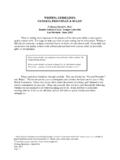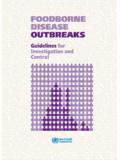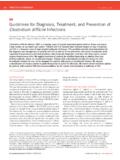Transcription of Clinical Practice Guidelines for Clostridium difficile ...
1 Infection control and hospital epidemiology may 2010, vol. 31, no. 5. shea-idsa guideline Clinical Practice Guidelines for Clostridium dif cile Infection in Adults: 2010 Update by the Society for Healthcare Epidemiology of America (SHEA) and the Infectious Diseases Society of America (IDSA). Stuart H. Cohen, MD; Dale N. Gerding, MD; Stuart Johnson, MD; Ciaran P. Kelly, MD; Vivian G. Loo, MD;. L. Clifford McDonald, MD; Jacques Pepin, MD; Mark H. Wilcox, MD. Since publication of the Society for Healthcare Epidemiology of America position paper on Clostridium dif cile infection in 1995, signi cant changes have occurred in the epidemiology and treatment of this infection.
2 C. dif cile remains the most important cause of healthcare . associated diarrhea and is increasingly important as a community pathogen. A more virulent strain of C. dif cile has been identi ed and has been responsible for more-severe cases of disease worldwide. Data reporting the decreased effectiveness of metronidazole in the treatment of severe disease have been published. Despite the increasing quantity of data available, areas of controversy still exist. This guideline updates recommendations regarding epidemiology, diagnosis, treatment, and infection control and environmental management.
3 Infect Control Hosp Epidemiol 2010; 31(5):431-455. executive summary 1. To increase comparability between Clinical settings, use available standardized case de nitions for surveillance This guideline is designed to improve the diagnosis and man of (1) healthcare facility (HCF)-onset, HCF-associated agement of Clostridium dif cile infection (CDI) in adult pa CDI; (2) community-onset, HCF-associated CDI; and (3). tients. A case of CDI is de ned by the presence of symptoms community-associated CDI (Figure 1) (B-III). (usually diarrhea) and either a stool test positive for C.
4 Dif cile 2. At a minimum, conduct surveillance for HCF-onset, toxins or toxigenic C. dif cile, or colonoscopic or histopath HCF-associated CDI in all inpatient healthcare facilities, ologic ndings revealing pseudomembranous colitis. In ad to detect outbreaks and monitor patient safety (B-III). dition to diagnosis and management, recommended methods 3. Express the rate of healthcare-associated CDI as the of infection control and environmental management of the number of cases per 10,000 patient-days (B-III). pathogen are presented. The recommendations are based on 4.
5 If CDI rates are high compared with those at other the best available evidence and practices , as determined by a facilities or if an outbreak is noted, stratify rates by patient joint Expert Panel appointed by SHEA and the Infectious location in order to target control measures (B-III). Diseases Society of America (IDSA) (the SHEA-IDSA Expert Panel). The use of these Guidelines can be impacted by the size of the institution and the resources, both nancial and II. Diagnosis: What is the best testing strategy to diagnose laboratory, available in the particular Clinical setting.
6 CDI in the Clinical laboratory and what are acceptable options? I. Epidemiology: What are the minimum data that should 5. Testing for C. dif cile or its toxins should be per . be collected for surveillance purposes and how should formed only on diarrheal (unformed) stool, unless ileus the data be reported? due to C. dif cile is suspected (B-II). From the Department of Internal Medicine, Division of Infectious and Immunologic Diseases, University of California Davis Medical Center, Sacramento, California ( ); the Research Service, Edward Hines Jr.
7 Veterans Affairs Hospital, and Infectious Disease Division, Department of Medicine, Loyola University Chicago Stritch School of Medicine, Maywood, Illinois ( , ); the Division of Gastroenterology, Beth Israel Deaconess Medical Center, Boston, Massachusetts ( ); the Department of Microbiology, McGill University Health Center, Montreal, Quebec, Canada ( ); the Division of Healthcare Quality Promotion, National Center for Preparedness, Detection, and Control of Infectious Diseases, Centers for Disease Control and Prevention, Atlanta, Georgia ( ); the Department of Microbiology and Infectious Diseases, University of Sherbrooke, Quebec, Canada ( ); and the Department of Microbiology, Leeds Teaching Hospitals National Health Service Trust and Institute of Molecular and Cellular Biology, University of Leeds, Leeds, United Kingdom ( ).
8 Received February 4, 2010; accepted February 5, 2010; electronically published March 22, 2010. 2010 by The Society for Healthcare Epidemiology of America. All rights reserved. 0899-823X/2010/3105-0001$ DOI: 432 infection control and hospital epidemiology may 2010, vol. 31, no. 5. 6. Testing of stool from asymptomatic patients is not is not recommended (A-III) and treatment of such iden . clinically useful, including use as a test of cure. It is not ti ed patients is not effective (B-I). recommended, except for epidemiological studies.
9 (B-III). B. Environmental Cleaning and Disinfection 7. Stool culture is the most sensitive test and is essential for epidemiological studies (A-II). 19. Identi cation and removal of environmental sources 8. Although stool culture is not clinically practical be of C. dif cile, including replacement of electronic rectal cause of its slow turnaround time, the sensitivity and spec thermometers with disposables, can reduce the incidence i city of stool culture followed by identi cation of a tox of CDI (B-II). igenic isolate (ie, toxigenic culture), as performed by an ex 20.
10 Use chlorine-containing cleaning agents or other perienced laboratory, provides the standard against which sporicidal agents to address environmental contamination other Clinical test results should be compared (B-III). in areas associated with increased rates of CDI (B-II). 9. Enzyme immunoassay (EIA) testing for C. dif cile 21. Routine environmental screening for C. dif cile is toxin A and B is rapid but is less sensitive than the cell not recommended (C-III). cytotoxin assay, and it is thus a suboptimal alternative ap . C. Antimicrobial Use Restrictions proach for diagnosis (B-II).
















